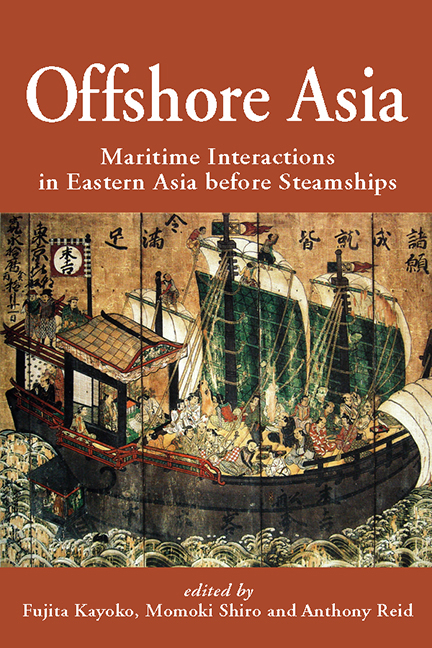Book contents
- Frontmatter
- Contents
- Maps
- Tables and Figures
- Preface
- Contributors
- Map 1 Eastern Asia in the 13th–16th Centuries
- 1 Introduction: Maritime Interactions in Eastern Asia
- 2 The Periodization of Southeast Asian History, in Comparison with that of Northeast Asia
- 3 Merchants, Envoys, Brokers and Pirates: Hokkien Connections in Pre-modern Maritime Asia
- 4 An Asian Commercial Ecumene, 900–1300 ce
- 5 The Japanese Archipelago and Maritime Asia from the 9th to the 14th Centuries
- 6 Saltpetre Trade and Warfare in Early Modern Asia
- 7 Shaping Maritime East Asia in the 15th and 16th Centuries through Choson Korea
- 8 Shipwreck Salvage and Survivors’ Repatriation Networks of the East Asian Rim in the Qing Dynasty
- 9 Wei Zhiyan and the Subversion of the Sakoku
- 10 Metal Exports and Textile Imports of Tokugawa Japan in the 17th Century: The South Asian Connection
- Bibliography of Works Cited
- Index
- NALANDA-SRIWIJAYA SERIES
Preface
Published online by Cambridge University Press: 21 October 2015
- Frontmatter
- Contents
- Maps
- Tables and Figures
- Preface
- Contributors
- Map 1 Eastern Asia in the 13th–16th Centuries
- 1 Introduction: Maritime Interactions in Eastern Asia
- 2 The Periodization of Southeast Asian History, in Comparison with that of Northeast Asia
- 3 Merchants, Envoys, Brokers and Pirates: Hokkien Connections in Pre-modern Maritime Asia
- 4 An Asian Commercial Ecumene, 900–1300 ce
- 5 The Japanese Archipelago and Maritime Asia from the 9th to the 14th Centuries
- 6 Saltpetre Trade and Warfare in Early Modern Asia
- 7 Shaping Maritime East Asia in the 15th and 16th Centuries through Choson Korea
- 8 Shipwreck Salvage and Survivors’ Repatriation Networks of the East Asian Rim in the Qing Dynasty
- 9 Wei Zhiyan and the Subversion of the Sakoku
- 10 Metal Exports and Textile Imports of Tokugawa Japan in the 17th Century: The South Asian Connection
- Bibliography of Works Cited
- Index
- NALANDA-SRIWIJAYA SERIES
Summary
This book was stimulated by the aim of deepening comparison and dialogue between historical research on Northeast Asia and that on Southeast Asia. Two centres collaborated in the joint research project which provided the groundwork for the book. One was the Asia Research Institute at the National University of Singapore. The Institute's Southeast Asia–China Interactions Cluster brought together scholars working on European-language, Chinese-language and Southeast Asian sources in an effort to understand the long-term relationships between China and her southern neighbours. The other was the Kaiiki Ajiashi Kenkyūkai — the Research Group of Maritime Asian History or Kaiikiken, established in 1993 and headquartered in Osaka, Japan. In cooperation with research groups on Central Asian history and early modern global history, the main axis for the activities of Kaiikiken's members was provided by the 21st Century Centre of Excellence Program “Interface Humanities” at Osaka University, 2003–7. Kaiikiken's principal research theme was the medieval and early modern maritime history of the area spanning Northeast and Southeast Asia. This work included exchange with scholars from Korea, China, Taiwan, and other regions. The Singapore and Osaka groups jointly hosted two international workshops: one in October 2004 in Okinawa titled “Northeast Asia in Maritime Perspective: A Dialogue with Southeast Asia” and one in Nagasaki in October 2006 titled “Dynamic Rimlands and Open Heartlands: Maritime Asia as a Site of Interactions”. This book is a selection of papers presented at these workshops, all extensively revised for publication. A series of smaller panels and seminars were also held on related themes, including a session titled “the European Presence in Early-Modern East and Southeast Asia: Examination of the Concept of Early-Modern Empire” at the International Association of Historians of Asia (IAHA) conference in Taiwan in December 2004.
We are grateful for the support for these activities furnished by the Japan Society for the Promotion of Science (the 21st Century Centre of Excellence Program at Osaka University “Interface Humanities”), the Suntory Foundation (“A Theoretical Study of Continuity and Discontinuity in ‘Early Modern’ and ‘Modern’ East and Southeast Asia”), and the Asia Research Institute.
- Type
- Chapter
- Information
- Offshore AsiaMaritime Interactions in Eastern Asia before Steamships, pp. ix - xPublisher: ISEAS–Yusof Ishak InstitutePrint publication year: 2013

